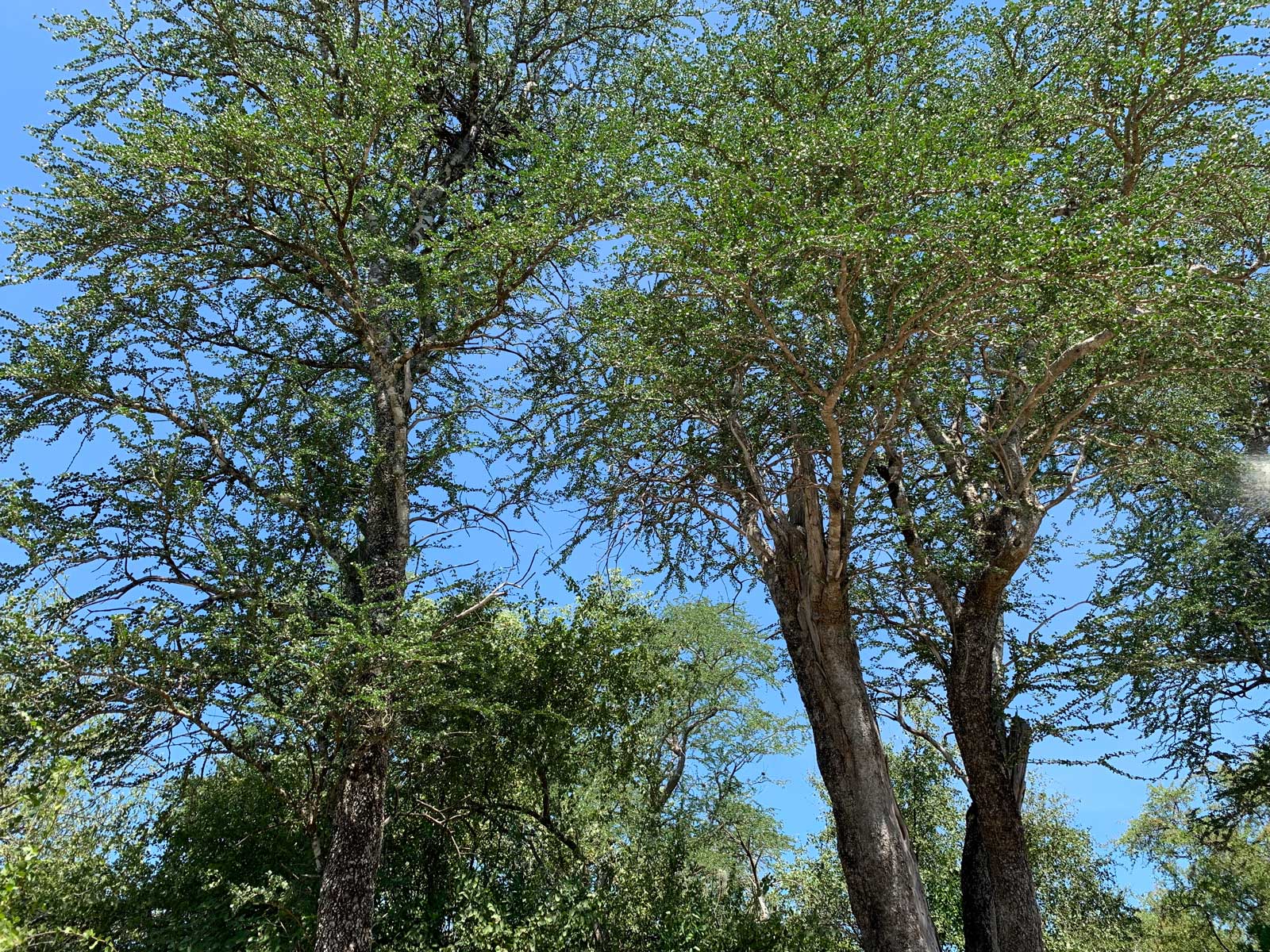Locally called “Palo Santo“ meaning “Sacred Wood” in Spanish, this tree grows in the unique biodiversity of El Chaco, formerly called the “Impenetrable Forest” for its incredibly dense and inhospitable formation.
El Chaco is the second biggest primary forest in Latin America after the Amazon Rainforest. NELIXIA’s Gaiacwood oil is sourced from management plans to ensure its long-term sustainability.
NELIXIA’s products
Crude Essential Oil
Purified Essential Oil
Fundamentals
KNOW
THE SOURCE
El Chaco, a xerophytic forest located in Paraguay, is a dry subtropical forest and is the only habitat for the Gaiacwood.
It contains the so-called Palosantales, meaning specific veins of vegetation with clayey and salty soils, where Gaiacwood thrives.
The highest concentration of Gaiacwood is in Paraguay due to its soil and climate conditions. Gaiacwood is still considered as very abundant, reported to range from 11 to 46 individuals/ha – from all tree ages, with 10M ha in Paraguay, the population is estimated at 3 billon gaiac trees in Paraguay*.
Gaiacwood is classified under Cites II “species that are not necessarily endangered, but whose trade must be controlled in order to avoid unsustainable conservation”
That’s why NELIXIA has created a new way of sourcing by establishing sustainable management practices for this resource.
(*Mereles and Pérez de Molas, 2008)
INVOLVE AND RESPECT
NELIXIA has developed a model to rent land from landowners in the Paraguayan Chaco in order to implement forest management plan for the extraction of Gaiacwood (harvest method validated by CITES), encouraging them to preserve and responsably manage the forest, without transforming the land into cattle farming. NELIXIA´s objective is to manage at least 20,000 ha in the El Chaco by 2023.
In 2022, our management plan has been verified by UEBT.
EMPOWER COMMUNITIES
PRESERVE, PROTECT AND
PROMOTE BIODIVERSITY
NELIXIA has already 4,800 ha under management plan for its sourcing and plans to have 20,000 ha by 2023.
Besides the sustainable harvesting, NELIXIA is also setting a research plan for the conservation of the species, looking to understand better the distribution areas, biology, ecology, population parameters of Gaiacwood, vegetation structure, natural regeneration, seedling mortality, tree growth rate, etc.
About Gaiacwood
Botany and production
Bulnesia sarmientoi (A.C. Godoy-Bürki), Palo Santo or Gaiacwood is a very solid and rustic tree. It has a very similar shape and growing to Mediterranean oaks or olive trees.
The gaiac tree is not planted, it naturally grows in clusters, following the salt veins of the clay soil.
With a very high regenerative capacity, it is able to produce new shoots from its roots even after short cut of the trunk, contributing to the maintenance of the population.
At maturity, it can reach 10 to 15 meters high and its diameter, up to 45 cm for a centennial guaiac. The tree with a brown-green trunk is distinguished by its butterfly-shaped leaves and its five-petal white flowers, present between April and May.
When the trunk reaches a diameter of 35 centimeters, it is mature enough to be cut. It takes about 80 years to reach this size; however, the tree can grow faster if the forest is well managed and has the necessary light.
This tree grows solely in the Chaco Region in South America and is the second biggest Latin American primary forest after the Amazonas.
Other unique trees like Quebracho blanco, Coronillo y Palo Borracho grow in this amazing forest formerly called the “impenetrable forest” for its incredibly dense and inhospitable formation and unique fauna species like Chaco Pekari, jaguar, giant anteater, tatu cart, gray deer, puma…
Botany and production
Bulnesia sarmientoi (A.C. Godoy-Bürki), Palo Santo or Gaiacwood is a very solid and rustic tree. It has a very similar shape and growing to Mediterranean oaks or olive trees.
The gaiac tree is not planted, it naturally grows in clusters, following the salt veins of the clay soil.
With a very high regenerative capacity, it is able to produce new shoots from its roots even after short cut of the trunk, contributing to the maintenance of the population.
At maturity, it can reach 10 to 15 meters high and its diameter, up to 45 cm for a centennial guaiac. The tree with a brown-green trunk is distinguished by its butterfly-shaped leaves and its five-petal white flowers, present between April and May.
When the trunk reaches a diameter of 35 centimeters, it is mature enough to be cut. It takes about 80 years to reach this size; however, the tree can grow faster if the forest is well managed and has the necessary light.
This tree grows solely in the Chaco Region in South America and is the second biggest Latin American primary forest after the Amazonas.
Other unique trees like Quebracho blanco, Coronillo y Palo Borracho grow in this amazing forest formerly called the “impenetrable forest” for its incredibly dense and inhospitable formation and unique fauna species like Chaco Pekari, jaguar, giant anteater, tatu cart, gray deer, puma…
Our value chain
The only way to ensure the sustainability of the Gaiacwood is by creating Forest Management Plans.
NELIXIA has since 2018, 4,800 ha under management plan.
A management plan consists in:
Inventory of the Forest
The first step in the management plan is to take a precise, thorough inventory of a forest sample. How many species are present? How old are the trees? How tall and wide are they?
Low-Impact Cutting
Once the inventory has been taken, a twenty-year forest management plan can be established.
After the sample is analyzed, trees mature enough to be cut are marked.
On average, six trees per hectare are cut down, which is enough to allow light to penetrate so the forest can grow back. Tree trunks are pruned by hand at 20 cm, and workers take care to never touch the roots to allow the trees to regenerate.
Twenty years later, when the plot is mature, the trees will have had enough time to grow back and can be harvested again. Gaiacwood is heavily present in the forest and is not endangered as long as the forest is managed well.
Carefully Organizing Logistics
The logistics of manually transporting tree trunks to trucks on the back roads—without ever damaging the ecosystem—is a real challenge. Each trunk weighs about one metric ton.
The forestry institute issues “guide” certificates that allow trucks to circulate from the forest to the distillation facility.
Act, Then Watch
Before and after every harvest, the plot must be examined to monitor regeneration. We examine and record the data so that we can continue to improve the process.
Our value chain
The only way to ensure the sustainability of the Gaiacwood is by creating Forest Management Plans.
NELIXIA has since 2018, 4,800 ha under management plan.
A management plan consists in:
Inventory of the Forest
The first step in the management plan is to take a precise, thorough inventory of a forest sample. How many species are present? How old are the trees? How tall and wide are they?
Low-Impact Cutting
Once the inventory has been taken, a twenty-year forest management plan can be established.
After the sample is analyzed, trees mature enough to be cut are marked.
On average, six trees per hectare are cut down, which is enough to allow light to penetrate so the forest can grow back. Tree trunks are pruned by hand at 20 cm, and workers take care to never touch the roots to allow the trees to regenerate.
Twenty years later, when the plot is mature, the trees will have had enough time to grow back and can be harvested again. Gaiacwood is heavily present in the forest and is not endangered as long as the forest is managed well.
Carefully Organizing Logistics
The logistics of manually transporting tree trunks to trucks on the back roads—without ever damaging the ecosystem—is a real challenge. Each trunk weighs about one metric ton.
The forestry institute issues “guide” certificates that allow trucks to circulate from the forest to the distillation facility.
Act, Then Watch
Before and after every harvest, the plot must be examined to monitor regeneration. We examine and record the data so that we can continue to improve the process.
Gaiacwood products
Gaiacwood Essential Oil Verifications performed by UEBT.
Level Attained: Ethical
UEBT verified Gaiacwood
Crude Essential Oil
Purified Essential Oil
Gaiacwood Essential Oil Verifications performed by UEBT.
Level Attained: Ethical
The wood is grounded into chips, before being steam distilled under pressure for about twenty-four hours. The result is an Essential Oil that must be kept warm in order to be processed. Indeed, the Crude Oil crystallizes and solidifies at room temperature. From this oil, it is possible to add a purification step to obtain the purified Gaiacwood Essential Oil.
Verification performed by UEBT. Level attained: Ethical.
VERIFICATION PERFORMED BY:

info@nelixia.com

